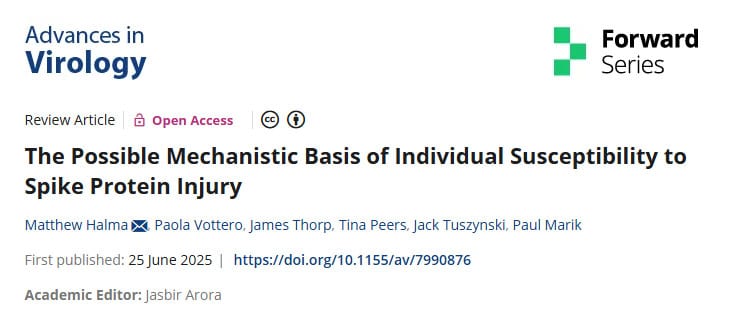New peer-reviewed study shows COVID vaccine injury risk isn’t equal. Some people are far more vulnerable to spike protein harm than others.

During the height of the COVID crisis, the vaccines were rolled out under a sweeping promise: they were “safe and effective” for everyone. Whether a petite adolescent or a large adult, everyone over the age of 12 received the same dose. But emerging new research suggests that approach may have made a risky injection even riskier for thousands of people.
A new peer-reviewed study published in Advances in Virology explores why some individuals are more vulnerable to harm from the vaccine-induced spike protein than others. The study makes clear: susceptibility to spike protein injury isn’t the same for everyone. That finding has major implications for treating post-vaccine illness, and also redefines what vaccine safety truly means.
“This new publication outlines the susceptibility factors going into post-acute COVID-19 vaccination syndrome, including genetic factors, and of course batch-related toxicity.” —Study Authors
It shows just how little thought was given to the simple fact that people’s bodies handle things differently. The idea of dosage is well understood—don’t take all the pills, just the right dose. Why would this be any different for injections? Let’s take a closer look at the study, co-authored by members of the IMA research team alongside leading physicians and scientists from across disciplines.
Mapping the Mechanisms of Harm
Published June 25, 2025, the study is titled “The Possible Mechanistic Basis of Individual Susceptibility to Spike Protein Injury” and is co-authored by Matthew Halma, Paola Vottero, Dr. James Thorp, Dr. Tina Peers, Dr. Jack Tuszynski, and Dr. Paul Marik. It provides a foundation for understanding why the spike protein affects people in vastly different ways.

The paper identifies four key factors that help explain individual vulnerability to vaccine-induced spike protein injury:
- The Vaccine Itself (dose, LNP formulation, contaminants)
- The Host (genetic factors, metabolic health)
- Administration (technique, aspiration)
- Pharmacogenomics (how your body metabolizes and reacts to the spike protein)
Each of these categories carries variation that can significantly alter how the body responds to exposure. One person might tolerate spike protein with little effect. Another, exposed to the same amount, could suffer debilitating symptoms.
“This study provides progress for the understanding of PACVS’s molecular mechanisms, and, depending on the symptom presentation, there may be different therapeutic approaches.” —Study Authors
Taken together, these variables paint a clear picture: imagine a patient who receives a high spike dose, has underlying metabolic issues, is injected without proper aspiration, and also happens to metabolize the spike protein slowly. The result? A much higher risk of injury.
Not All Bodies (or Batches) are Alike
The study goes deeper, naming specific susceptibility markers like ACE2, p53, BRCA1, and CD147. It also points to procedural issues: dose inconsistencies, lack of aspiration during injection, and lipid nanoparticle variability. One especially concerning factor is batch-related toxicity. Though under-reported, this has become a key area of concern for independent researchers around the globe.
These details matter because they dismantle the idea that the same intervention can work safely and uniformly for everyone. From top to bottom, the rollout of COVID vaccines operated on a one-size-fits-all model. This paper makes clear: the science never supported that premise.
From Data Suppression to Data-Driven Care
Why does this study matter now? Because millions were coerced into receiving an injection under pressure, and many were ridiculed or punished for asking rational questions.
Today, much of that caution has been vindicated. Multiple European countries have removed COVID shots from their recommendations for children and pregnant women. The U.S. HHS has recently done the same. And at IMA, our Smart Moms Ask resource center continues to provide evidence-based resources for families navigating this landscape.
This study helps explain what many have witnessed firsthand: wildly different outcomes from the same shot. In doing so, it opens the door for smarter, safer, more individualized care.
This isn’t a one-off publication. It is part of a growing research program led by the Independent Medical Alliance to better understand post-acute COVID-19 vaccination syndrome (PACVS).
“With this work, we wish to fire the opening shot in a research program directed at understanding the biological pathways by which PACVS manifests. This helps us to understand pathological (and therapeutic) mechanisms for PACVS. This will aid in treatment, and—we hope, provide hope for those with PACVS.” —Study Authors
IMA is uniquely positioned to lead in this space. We support patients through clinical protocols, provider education, public advocacy, and scientific publishing. Recently, we released another peer-reviewed study co-authored by Matthew Halma and Dr. Joseph Varon defining PACVS as a distinct medical condition. This effort builds on that foundation.
We also launched the Journal of Independent Medicine this year to provide a home for credible, uncensored, patient-centered research.
The Path Forward
This study offers a starting point for precision-guided care. It highlights the potential of biomarkers to help distinguish vaccine injury from viral infection. That kind of diagnostic clarity can enable targeted treatments, better protection for high-risk individuals, and informed decision-making for future vaccine policies.
It also affirms what has long been denied: that some people are more vulnerable, and that the system has failed to protect them.
In advancing the science, we also hope to offer something more—real hope for those living with PACVS, and a healthcare system that learns from its mistakes.
📚 More IMA research and resources:
Support the Future of Honest Medicine
IMA is dedicated to restoring transparency, improving patient outcomes, and changing the conversation around COVID vaccine harm.
We invite you to be part of that mission. Your support helps us expand our research, build tools for patients and providers, and share the truth that others still ignore.
Please consider making a donation today.




